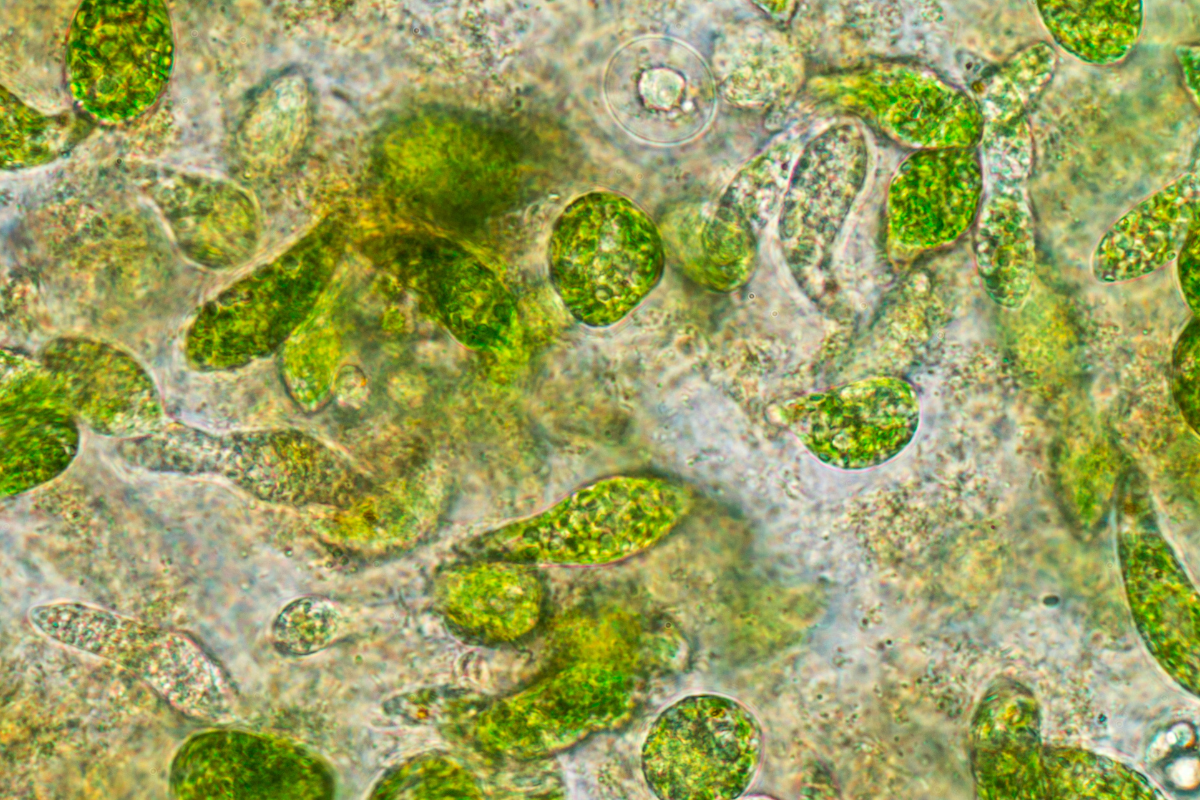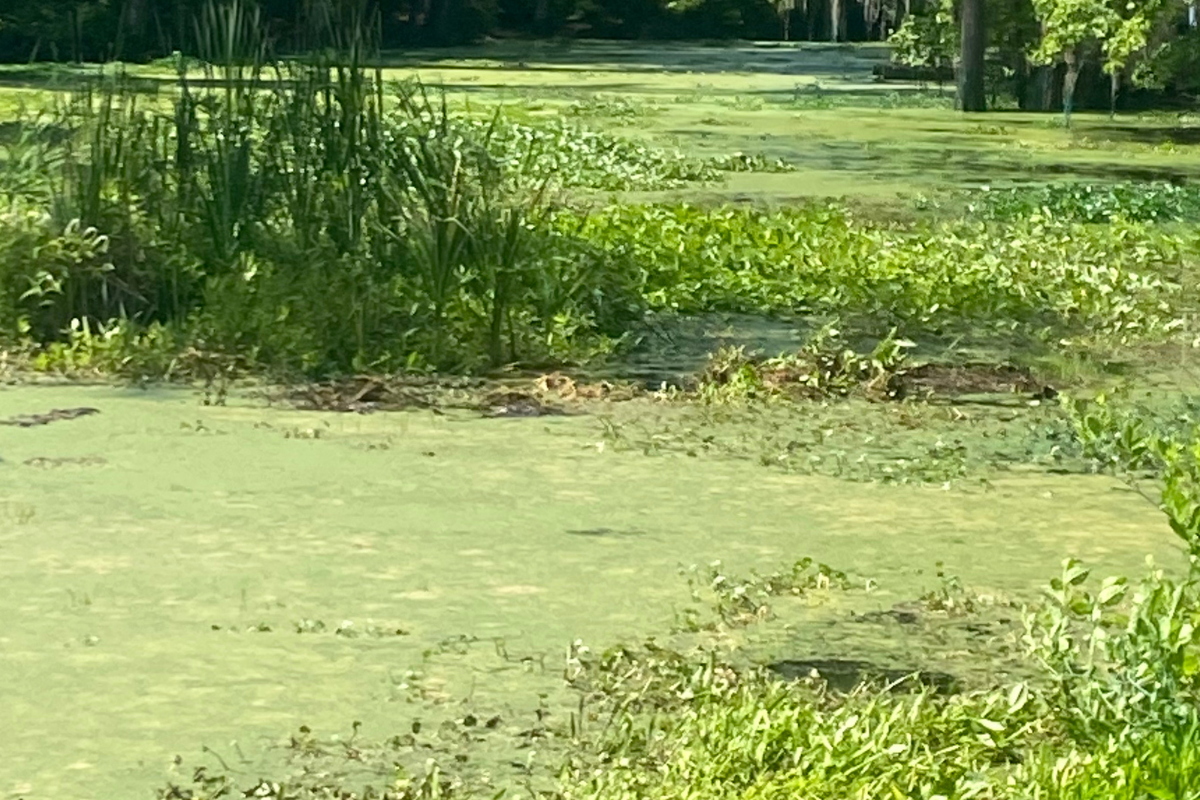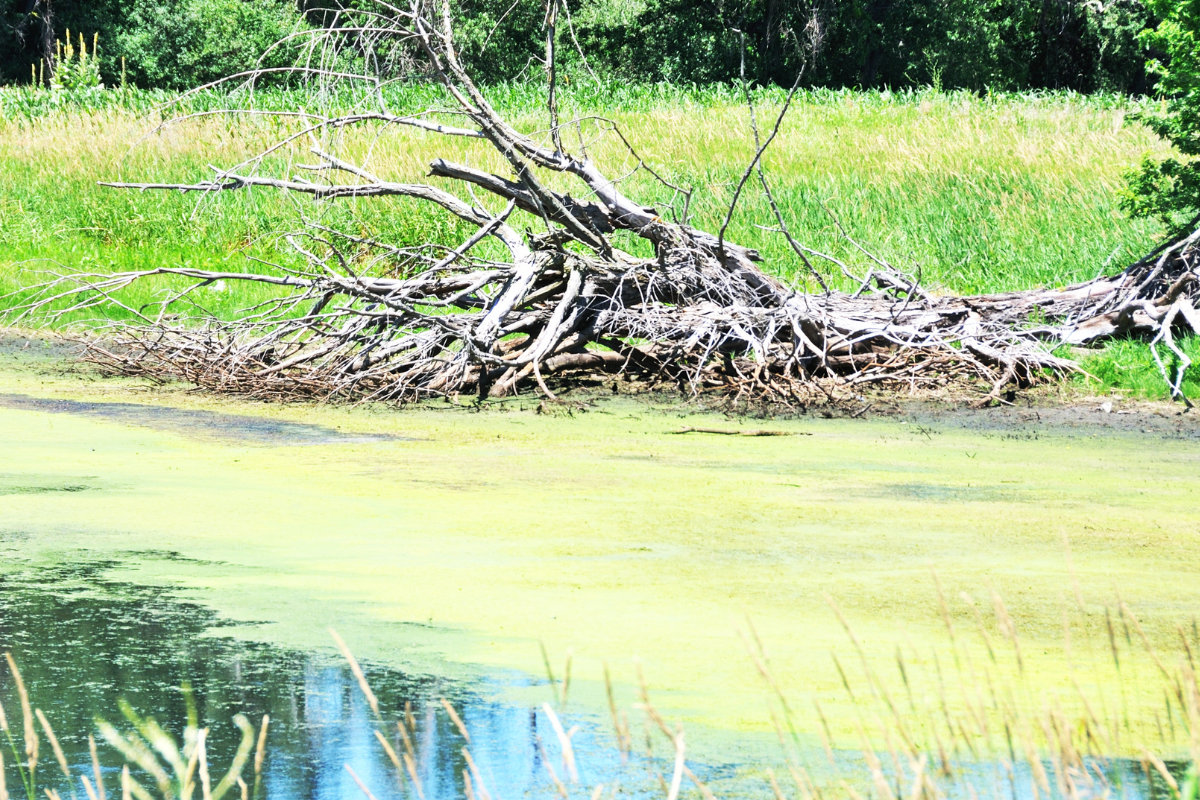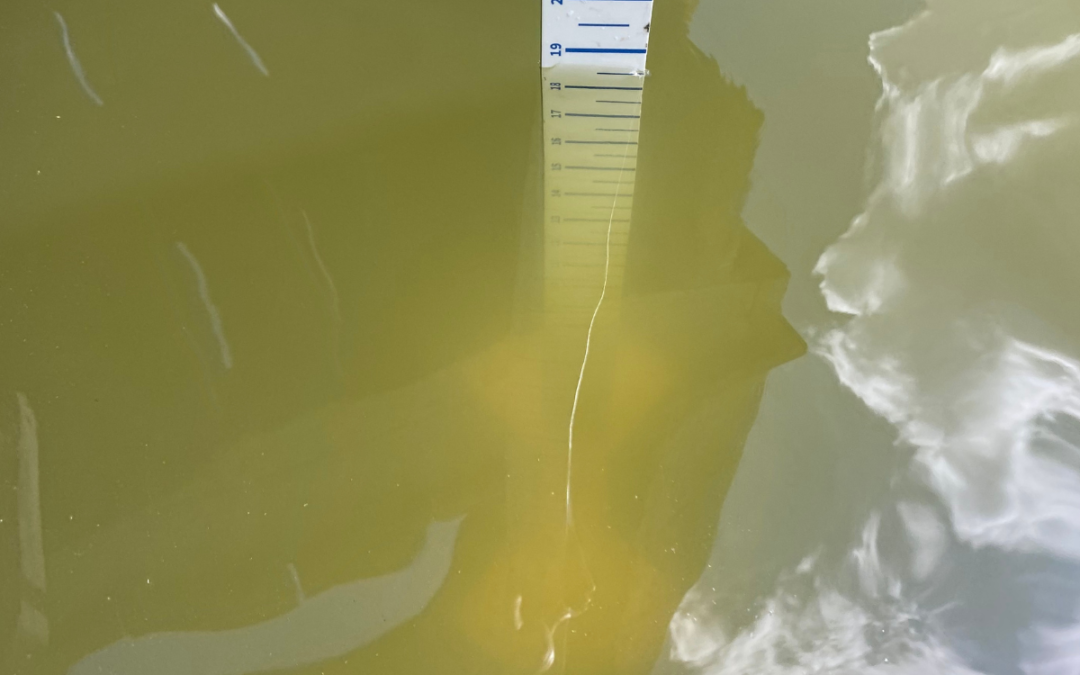The term “algae” is often used as a blanket term to describe many different types of pond vegetation. There are some forms of “algae” that we want to encourage in a pond ecosystem, but there are also other types of algae that we closely monitor and manage to prevent overpopulation. Below we’ll compare “good algae” and “bad algae” in a pond ecosystem.

Good Algae: Phytoplankton
Phytoplankton, microscopic plant-like organisms that drift in water bodies, play a critical role in the health and sustainability of aquatic ecosystems. In fishing ponds, a robust “good algae” population is essential for various reasons, ranging from supporting the food web to enhancing water quality.
Foundation of the Food Web
Primary Producers: Phytoplankton are the primary producers in aquatic ecosystems, forming the base of the food web. They convert sunlight into energy through photosynthesis, creating organic matter that serves as the primary food source for zooplankton. Zooplankton, in turn, are consumed by small fish, which are preyed upon by larger fish. Without a healthy phytoplankton population, the entire food web would collapse, leading to a decline in fish populations and overall pond health.
Nutrient Cycling: Phytoplankton play a crucial role in nutrient cycling. They absorb nutrients such as nitrogen and phosphorus from the water, incorporating them into their biomass. When phytoplankton die and decompose, these nutrients are released back into the water, making them available for other organisms. This cycling of nutrients is essential for maintaining the productivity of the pond and supporting a diverse array of aquatic life.
Enhancing Fish Growth and Health
Food Availability: A strong phytoplankton population ensures a steady supply of food for the pond’s inhabitants. Larval and juvenile fish depend heavily on zooplankton, which feed on phytoplankton. As fish grow, they continue to rely on a food web that originates with phytoplankton. Therefore, a rich phytoplankton population is directly linked to higher survival rates, faster growth, and better health of fish in the pond.
Natural Feed: Many fish species exhibit improved growth and coloration when they consume natural prey, including zooplankton and other small organisms that depend on phytoplankton. This natural diet often leads to healthier fish compared to those raised on artificial feeds alone. Strong phytoplankton populations contribute to the availability of these natural feed sources, enhancing the overall quality of the fishery.
Water Quality and Clarity
Oxygen Production: Through photosynthesis, phytoplankton produce oxygen, which is dissolved in the water and available for aquatic organisms. Adequate oxygen levels are critical for the survival of fish and other aerobic organisms. During daylight hours, a healthy phytoplankton population can significantly contribute to maintaining optimal oxygen levels in the pond, especially during periods of high biological activity.
Nutrient Management: Phytoplankton absorb nutrients that would otherwise contribute to algal blooms, which can lead to eutrophication and poor water quality. By outcompeting harmful algae for nutrients, phytoplankton help maintain a balanced aquatic ecosystem. This balance prevents excessive algal growth, which can result in oxygen depletion, fish kills, and the release of toxins harmful to aquatic life and humans.
Light Competition
Shading Effect: Phytoplankton, being microscopic plant-like organisms, float in the water column and perform photosynthesis near the surface where light is abundant. When phytoplankton populations are healthy and thriving, they can create a shading effect by absorbing and blocking sunlight from penetrating deeper into the water. This reduction in light availability at lower depths inhibits the growth of subsurface weeds, which require sunlight for photosynthesis.
Limiting Photosynthesis for Weeds: Subsurface weeds, such as rooted aquatic plants, need sufficient light to photosynthesize and grow. By shading the water and reducing light penetration, phytoplankton can directly limit the ability of these weeds to produce the energy they need for growth and reproduction. Over time, this can lead to a decline in weed density and vigor.

Bad Algae: Filamentous Algae aka Pond Scum
Filamentous algae, often referred to as “pond scum” or “moss,” are a type of algae that grow in long, stringy, and web-like structures. While they are a natural part of many aquatic ecosystems, an overgrowth of filamentous algae can pose significant problems for a fishing pond. Understanding the detrimental effects of excessive filamentous algae is crucial for maintaining the health and balance of the pond environment. This blog explores the various ways in which overgrown filamentous algae can negatively impact a fishing pond, affecting water quality, fish health, and overall ecosystem stability.
Oxygen Depletion
Respiration at Night: Filamentous algae, like all plants, undergo photosynthesis during the day, producing oxygen and consuming carbon dioxide. However, at night, they switch to respiration, consuming oxygen and releasing carbon dioxide. In large quantities, this nocturnal oxygen consumption can significantly reduce dissolved oxygen levels in the pond, especially during the early morning hours. Low oxygen levels can stress or even kill fish and other aerobic aquatic organisms.
Algal Blooms and Die-Offs: When filamentous algae experience rapid growth, they eventually undergo die-offs. The decomposition of large amounts of dead algae by bacteria further depletes oxygen levels in the water. This process, known as biological oxygen demand (BOD), can create hypoxic (low oxygen) conditions, leading to fish kills and the loss of other aquatic life.
Water Quality Degradation
Nutrient Imbalance: Overgrown filamentous algae can indicate an imbalance of nutrients, particularly excess nitrogen and phosphorus. These nutrients often enter the pond from runoff containing fertilizers, animal waste, or decaying plant matter. High nutrient levels promote the rapid growth of algae, which can outcompete other aquatic plants and phytoplankton, disrupting the natural nutrient cycling and balance of the pond.
Turbidity and Light Penetration: Thick mats of filamentous algae can float on the water’s surface, reducing light penetration into the pond. This decrease in light availability affects submerged aquatic plants and phytoplankton, which rely on sunlight for photosynthesis. Reduced photosynthesis can further lower oxygen production and overall pond productivity.
Habitat Disruption
Fish and Invertebrate Movement: Dense growths of filamentous algae can create physical barriers that hinder the movement of fish and other aquatic organisms. Fish may find it difficult to navigate through thick algal mats, leading to stress and reduced feeding efficiency. Invertebrates, which serve as a food source for many fish species, may also be affected, impacting the entire food web.
Spawning and Nursery Areas: Filamentous algae can cover and smother spawning grounds and nursery areas, making it difficult for fish to lay eggs and for young fish to find suitable habitat. This disruption can lead to a decline in fish reproduction and the overall health of the fish population in the pond.
Aesthetic and Recreational Concerns
Unsightly Appearance: Overgrown filamentous algae can make a pond look unattractive and unkempt. Thick mats of algae floating on the surface or clinging to the shoreline can deter recreational activities such as fishing, boating, and swimming. For pond owners and managers, maintaining the aesthetic appeal of the pond is often important for enjoyment and property value.
Foul Odors: As filamentous algae die and decompose, they can produce foul odors, further diminishing the recreational value of the pond. These odors are often caused by the release of gases such as hydrogen sulfide during the decomposition process, which can be unpleasant for people nearby.

How to Get More Good Algae?
If your pond water is crystal clear, that’s a good indication that you don’t have enough good algae. A pond with a green tint to the water is an indication that you do have a solid population of good algae. Ideally we like to see a pond with a visibility in the range of 18-24″.
Ponds located near agricultural sources usually have plenty of nutrient runoff to sustain a proper phytoplankton population. This could include runoff from livestock or runoff from crops where fertilizer is used to promote growth. These ponds almost always have plenty of good algae and don’t require management to promote their growth.
But ponds that aren’t located near runoff sources will often need management to maintain populations of good algae. Many of the ponds we manage will get lime added in the winter months, which helps to release bound nutrients in the pond sediment. These nutrients are then available to the good algae so they can bloom.
We also fertilize ponds in the spring months to supplement nutrients for the good algae. This is an instant and fast addition of nutrients to the water where the phytoplankton can utilize them quickly. Fertilization, although not necessary in all cases, is a quick way to stimulate a bloom of good algae.
Let Up Help with Your Pond!
If you’re in the south GA or north FL region and need help improving the good algae or reducing the bad algae in your pond, complete this form and we’ll contact you to schedule a time to meet.

